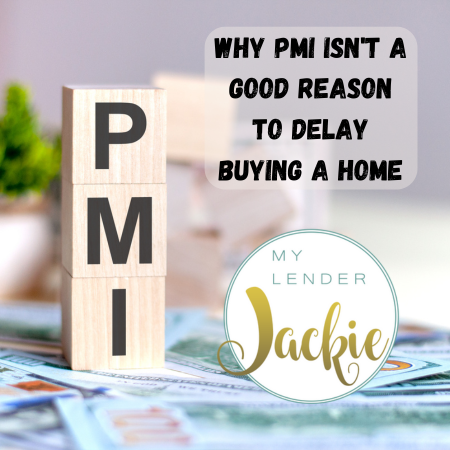
While it’s true that PMI adds to your monthly mortgage payment, it shouldn’t necessarily hold you back from purchasing your dream home. In fact, waiting to buy a home just to avoid PMI might end up costing you more in the long run, especially in a market where home prices are rising. Let’s break down why PMI isn’t the roadblock it seems to be and how you can eventually get rid of it.
What Is PMI and Why Do You Need It?
PMI stands for Private Mortgage Insurance, and it is typically required if you’re putting less than 20% down when buying a home. It protects the lender in case you default on the loan, but the cost of PMI is passed on to you, the borrower.
PMI is usually calculated as a percentage of the loan amount, costing anywhere from 0.3% to 1.5% annually. For example, on a $600,000 loan, PMI might add $150 to $750 to your monthly mortgage payment.
While PMI may feel like an extra burden, it plays a key role in helping you get into a home with less upfront cash. Without PMI, many buyers would have to save for years longer to afford a 20% down payment, potentially missing out on home appreciation in the meantime.
Why PMI Shouldn’t Delay Your Home Purchase
There are a few reasons it’s not usually a good idea to wait until you don’t have to pay private mortgage insurance.
Rising Home Prices Will Likely Outpace Your Savings
If you’re delaying your purchase to save for a larger down payment, you may find that home prices have risen significantly by the time you’re ready. This can make it even harder to buy a home, as both the down payment and monthly payments on a higher-priced home will be more expensive.
For example, if home prices increase by 5% annually, a $400,000 home today could cost $420,000 next year. That $20,000 increase could wipe out your progress toward avoiding private mortgage insurance.
Unless you expect to come into the money you’ll need for the 20% down payment next year or something, it’s usually not worth waiting. Most buyers simply can’t save faster than the market is going to grow. When you buy with PMI, you’re letting the market do the work as a sort of passive savings account, building equity rather than actively depositing into a savings account.
Building Equity
The longer you wait to buy, the longer you delay building equity in a home. Homeownership is one of the most reliable ways to build wealth over time, and the sooner you start, the better. PMI may feel like a short-term expense, but owning a home allows you to build long-term value as property values appreciate.
Changing Interest Rates
Mortgage rates fluctuate, and there’s no guarantee they’ll remain low while you save for a bigger down payment. Even if you avoid PMI by waiting, higher interest rates could result in higher overall costs for your loan.
PMI Doesn’t Last Forever
Remember, private mortgage insurance isn’t a permanent cost. Once you’ve built enough equity in your home, you can remove it, so it is only a temporary inconvenience rather than a long-term burden. In most California markets, buyers are able to reach that 20% equity threshold far more quickly than just paying into the principal. Market growth does the heavy lifting.
How to Stop Paying
The best part about PMI is that you don’t have to pay it forever. It is simply a means to an end, and that end is becoming a homeowner more quickly. There are a few ways you can potentially stop paying PMI after you close on your home.
Pay Down Your Principal
The most straight forward way to stop paying PMI is to pay down your principal until you have reached 20% equity, or paid at least 20% of the home off. As you make payments on your mortgage, you gradually build equity in your home. Once your loan balance reaches 80% of your home’s original value (or current value with an appraisal), you can request your lender to cancel PMI. You can monitor your mortgage payments to see how close you are to this threshold.
Refinance Your Mortgage
If home values have appreciated or you’ve made significant payments toward your loan, or a combination or both, refinancing could be a smart move. By refinancing, you may be able to secure a new loan without private mortgage insurance if your new loan amount is less than 80% of the home’s value.
Let’s say you originally bought a $500,000 home and put 10% ($50,000) down. Two years later, if the value of the home has increased by $50,000 or more, and/or you’ve paid down enough of the principal to add up to a total of $100,000, you can leverage that equity to refinance out of PMI. We know refinancing can be confusing, but we’re happy to help you by answering questions and sharing resources.
Make Extra Payments
If your budget allows, consider making extra payments on your mortgage principal. This can help you reach the 80% loan-to-value (LTV) ratio more quickly. Even small additional payments add up over time and bring you closer to canceling PMI.
Automatic PMI Removal
By law, lenders are required to automatically remove PMI when your loan balance reaches 78% of the home’s original value, as long as you’re current on payments. This means you won’t need to take any extra steps, but keep in mind this method may take longer than actively paying down your principal. Either way, remember that PMI is a temporary part of your homeownership journey.
Want to learn more about applying for a mortgage or what you can afford? We’re here to help you reach your homeownership goals, so contact us any time.

